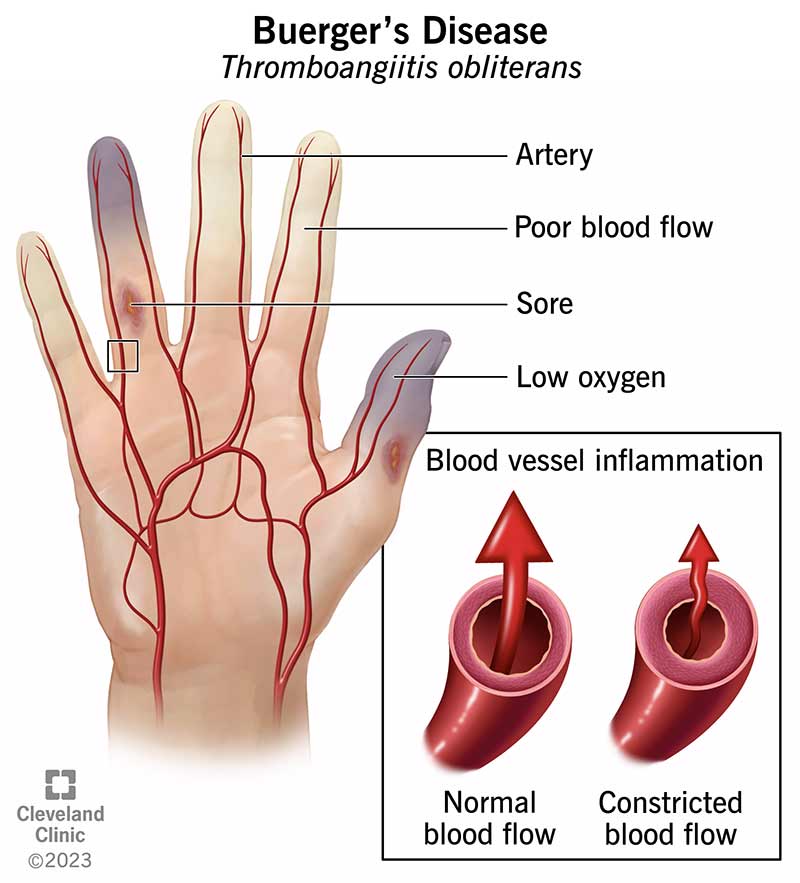Buerger’s disease (thromboangiitis obliterans) is a rare disease most often found in those who smoke. The blood vessels in their legs, arms, feet and hands get inflamed, making it hard for blood to travel through. Clots make the issue worse, leading to pain and damaged tissue. Quitting smoking is the best way to make symptoms better.
Advertisement
Cleveland Clinic is a non-profit academic medical center. Advertising on our site helps support our mission. We do not endorse non-Cleveland Clinic products or services. Policy

Buerger’s disease (thromboangiitis obliterans) is a rare disease of the blood vessels in your arms, legs, fingers and toes. Inflammation in your blood vessels makes it hard for your blood to flow through them. Blood clots can form, which create obstacles inside your blood vessels. As a result, you can have pain and damaged tissues starting in your fingers and toes and spreading to your arms and legs.
Advertisement
Cleveland Clinic is a non-profit academic medical center. Advertising on our site helps support our mission. We do not endorse non-Cleveland Clinic products or services. Policy
With fewer people smoking, Buerger’s disease is rare. Out of every 100,000 people in America, only 12 to 20 people have it. Other countries with more tobacco use have more cases of Buerger’s disease.
Early signs of Buerger’s disease include severe pain in your legs and arms. This pain happens when your body is resting.
Buerger’s disease symptoms develop slowly over time. Symptoms include:
Other Buerger’s disease symptoms may happen after you’ve had it for a while. These include:
The cause of Buerger’s disease isn’t known, but scientists think something in tobacco hurts the lining in your blood vessels. Most people with Buerger’s disease use tobacco.
Your genes may make you more likely to get Buerger’s disease. Some scientists think it’s an autoimmune disease.
Buerger’s disease risk factors include:
Advertisement
Rare complications of Buerger’s disease (thromboangiitis obliterans) include:
Your healthcare provider will consider results from:
Your provider can look at your blood vessels with these tests:
There’s no cure for Buerger’s disease, but stopping all tobacco, marijuana and nicotine use is the best way to keep Buerger’s disease from getting worse. Providers also recommend avoiding secondhand smoke (other people’s smoke).
The disease can keep getting worse even if you only smoke one cigarette each day.
When people with Buerger’s disease stop smoking, their symptoms usually get better. In some people, the disease goes into remission (becomes inactive) once they stop smoking.
Specific medicines can help with your Buerger’s disease symptoms.
Some medications are helpful in Buerger’s disease treatment, including:
You may get relief from Buerger’s disease symptoms with:
Quitting smoking has no side effects. It improves your health in many ways.
All medications have possible side effects, and they vary by drug. Your provider will carefully consider the best medication for you.
Amputation of a finger or toe may lead to swelling, pain or infection.
Spinal cord stimulation has a number of risks, including:
As there’s no cure for Buerger’s disease, you’ll keep having symptoms for as long as you smoke. You’ll also need medicines and possibly surgeries. But if you quit smoking, you can make your symptoms better.
Symptoms last from one to four weeks at a time, but they usually come back. Quitting all tobacco products, nicotine and marijuana is the best way to control Buerger’s disease symptoms.
Although there’s no cure for Buerger’s disease, you can quit using tobacco products to keep it from getting worse. If you keep using tobacco products, you’ll need medicines and possibly surgeries to help you with your symptoms. If your condition gets really bad, your provider may need to remove one or more of your toes or fingers.
Advertisement
To avoid getting Buerger’s disease, don’t smoke or use tobacco of any kind. You should avoid nicotine patches and marijuana as well.
The best thing you can do is to stop using any type of tobacco to keep Buerger’s disease from getting worse. You should also avoid nicotine patches and marijuana, as these may allow Buerger’s disease to continue or worsen.
About 50% of the people with Buerger’s disease who keep using tobacco end up needing to have a finger or toe removed (amputation). People with Buerger’s disease who quit smoking hardly ever need an amputation.
Other recommendations include:
Get help if you have Buerger’s disease symptoms or if your symptoms get worse. If you have Buerger’s disease, you should have regular check-ups with your provider.
Call 911 if you think you’re having a heart attack or stroke. Also, you may need emergency surgery if Buerger’s disease has affected your intestines or if infection makes it necessary for a provider to remove your fingers or toes.
Advertisement
Raynaud’s disease or syndrome can be a symptom of Buerger’s disease. With Raynaud’s disease, the blood vessels in your toes and fingers collapse because you’re feeling cold or you’re under stress. The lack of enough blood getting through your blood vessels makes your skin look white or blue. After a few minutes or hours, your skin looks red and can feel numb or tingly.
Simply warming up your hands, wearing gloves or wearing warm socks can help relieve the symptoms. Buerger’s disease is painful and has many more symptoms than Raynaud’s disease.
Buerger’s disease is a rare issue with the blood vessels in your fingers, toes, arms and legs. While you can take medicines for your symptoms, the best treatment for Buerger’s disease is to quit smoking. Most people with Buerger’s disease get relief from their symptoms when they stop smoking. Ask your provider to help you quit smoking so you can feel better.
Advertisement
Vascular disease may affect your life in big and small ways. Cleveland Clinic’s specialists treat the many types of vascular disease so you can focus on living.

Last reviewed on 05/03/2023.
Learn more about the Health Library and our editorial process.